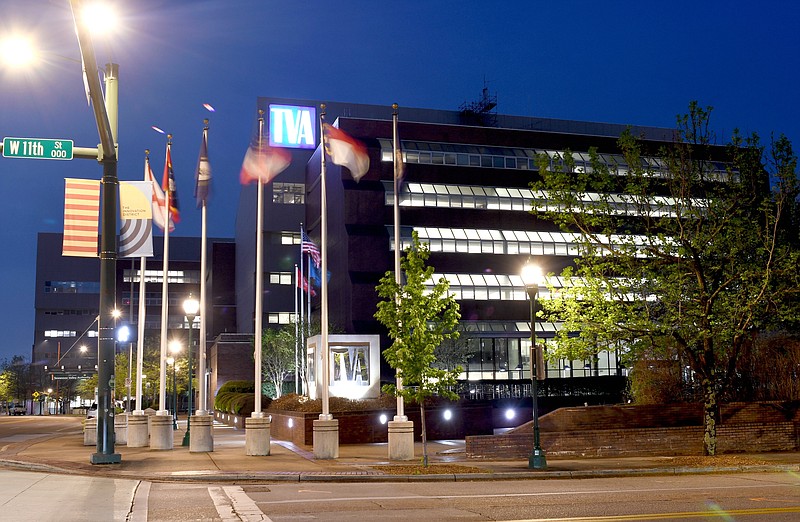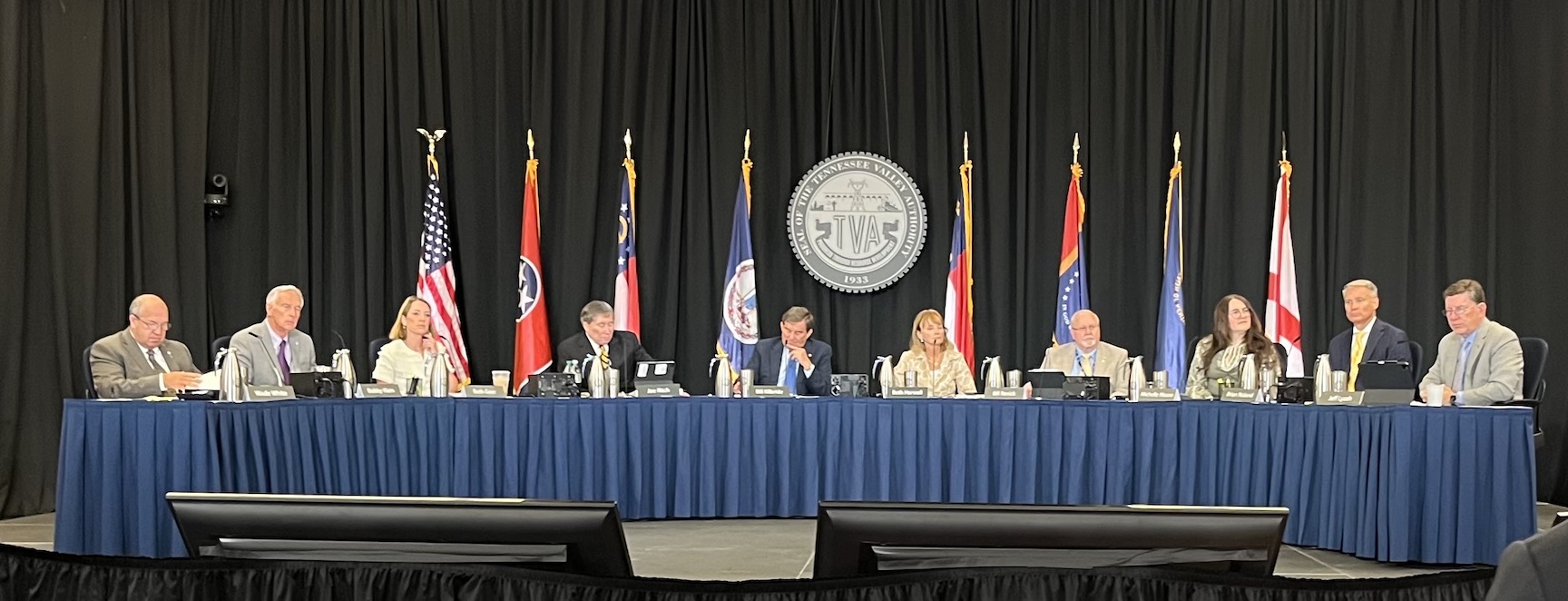The Tennessee Valley Authority will raise its base electric rates this fall for the first time in four years and end a credit program that helped EPB and other local power companies limit their rate increases during the pandemic.
Faced with higher inflation, interest rates and power demand, TVA directors voted Thursday to boost electricity rates by 4.5%, starting Oct. 1.
Under the $12.5 billion budget plan approved by TVA directors during their quarterly meeting in Chattanooga, power rates will rise $3.50 a month for the typical residential customer of TVA. Many local power companies are likely to add still more to the rate increase after TVA ends its three-year-old pandemic credit program.
EPB has already approved a rate increase for its electric customers this fall, which is expected to raise the typical residential electric bill in Chattanooga by about $5 a month. The combined increases from EPB and TVA are expected to add more than $8 a month to the typical residential electric bill in Chattanooga this fall.
In total, TVA's wholesale rate hike will raise another $450 million to help offset higher inflation, interest rates and power demand, TVA Chief Financial Officer John Thomas said. The TVA rate hike is the biggest by the federal utility in more than a decade, and officials acknowledged there may be more rate increases coming in the next few years.
The rate hike comes only midway through what TVA had hoped would be a decade of stable base power rates. Although TVA has raised power prices to reflect its higher fuel costs, the federal utility adopted a long-range power plan four years ago that officials hoped at the time would avoid any base rate increases for the next decade.
"What changed was inflation and interest rates, which have driven up our costs," TVA President Jeff Lyash said in an interview. "But there is also this press for expansion to keep up with the increase in demand we're seeing and expect to continue to grow."
In the past, TVA was able to offset higher prices to keep rates constant. But that is no longer possible, Lyash said, even as he said he is doubling down on cost containment programs.
Even with TVA's top AAA bond rating, the federal utility is paying about 5% on most of its bonds today, Thomas said. TVA has one of its older bonds maturing next year that previously carried an interest charge of 2.875%.
"Our refinancing rates have almost doubled from where they were in the past, and then we are going to have to also finance more new generation," he said.
Thomas said TVA has seen about a 7% increase in the cost of goods and services in the past year, and employee salaries — TVA is required to pay the industry prevailing wage — are up from 4% to 6% in the past year.
"TVA is not immune to cost increases, inflation and supply chain challenges," Lyash told the TVA board.
Base rate rise, fuel costs drop
While TVA base rates are going up, the fuel cost portion of electricity bills is down from the record highs reached last summer when fuel prices spiked after the Russia-Ukraine war. With fuel prices dropping this year and projected to do the same next year, TVA projects its delivered cost of power, which jumped by more than 15% last year, will be about the same in fiscal 2024.
"Our projection is that fuel costs will continue to go down next year," Thomas told the TVA board. "The effective rate will remain essentially flat."
(READ MORE: TVA's plans to build natural gas plants ignite fiery debate)
Even with the pandemic credits ending and with higher wholesale rates, Thomas projects the drop in the fuel-cost portion of electric bills will help TVA cut its effective delivered price of electricity from an average of 7.61 cents per kilowatt-hour this year to 7.59 cents per kilowatt-hour next year.
The projected price of power next year will still be 15% above what it was in 2021, when the pandemic pushed down fuel prices and the cost of power.
Through the pandemic, TVA provided $680 million in credits for 153 local power companies that distribute its power, but such credits will end next month.
Doug Peters, president of the Tennessee Valley Public Power Association, which represents the local utilities that distribute TVA power across its seven-state region, said the growth of electricity demand "necessitates that TVA prioritize resource plans and capital investments to meet the needs of the future.
"In this economy, it is necessary that TVA raise rates to prepare the generation resources needed to meet an increasingly electrified economy with reliability, resiliency and sustainability," Peters said in a statement after the board voted to raise rates. "While we anticipated the need for a rate increase, we did not anticipate that it would go into effect so quickly."
Peters said he hopes the long-range power projections being prepared for TVA's new Integrated Resource Plan will map out a cost-effective and reliable power strategy through 2050.
Electrifying the Valley
TVA's power demand, which remained relatively stable and even declined during the pandemic, has begun to rise and is projected to double by 2050 as gas-powered cars are replaced with electric vehicles and TVA's region continues to attract new industry and relocating Americans.
TVA's growing power demands will require the utility to build as much new power generation in the next three decades as it did in its entire history until now, Lyash said. Power demand is being propelled by industrial growth and immigration to the Tennessee Valley, which is growing three times the U.S. average.
New industries are being added across the Tennessee Valley needing an extra 3,000 megawatts of electricity, "and we still have a pipeline of future industrial growth," Lyash said.
"It took us 90 years to build our current power system," Lyash said. "In the next 30 years, we will have to double or triple the current systems at a speed unlike any other time in TVA history."
TVA invested about $25 billion in its power system in the past 10 years. TVA will invest another $15 billion to expand and upgrade generation in the next three years. with work on new natural gas generators, small modular reactors, pumped hydro storage plants and other new generation, Lyash said.
In the next fiscal year, TVA is boosting its capital budget to a record high of $4.2 billion, and the utility projects it will spend $6 billion in fiscal 2025.
TVA also is also budgeting an extra $100 million for programs to offer incentives and aid to help cut both residential and industrial power use. TVA hopes to offset 30% of its future load growth through efficiency and conservation programs, TVA Vice President Buddy Eller said.
TVA has launched a cost optimization initiative to help offset higher expenses and cut a projected $950 million in costs during the next three years. But Lyash acknowledged "there is sustained upward price pressure" that could require additional rate increases in future years as TVA invests more to build new power generation.
Comparing utilities
Even with the rate increase, TVA electricity rates will still remain below most other utilities, Lyash said. Residential power rates in TVA's service area are lower than more than 70% of other utilities, according to the most recent data from the U.S. Energy Information Administration. Neighboring Georgia Power Co., owned by the Southern Co., raised its rates by 12% in June.
Neighboring utilities to TVA have gained approval or already implemented $6.6 billion in rate increases since February 2022, Thomas said.
"Even with this increase, we think we will still stay within the top quartile (with the lowest 25% of electricity rates in the nation)," Thomas said.
TVA industrial rates are in the lowest 10% of all utilities, according to Energy Information Administration data.
Contact Dave Flessner at dflessner@timesfreepress.com or 423-757-6340.

